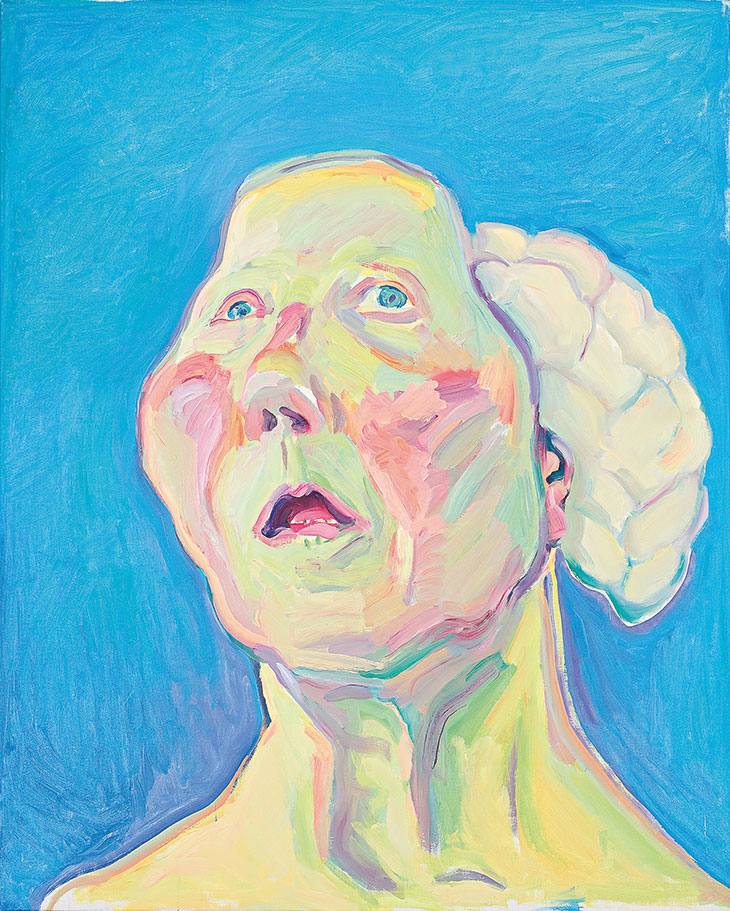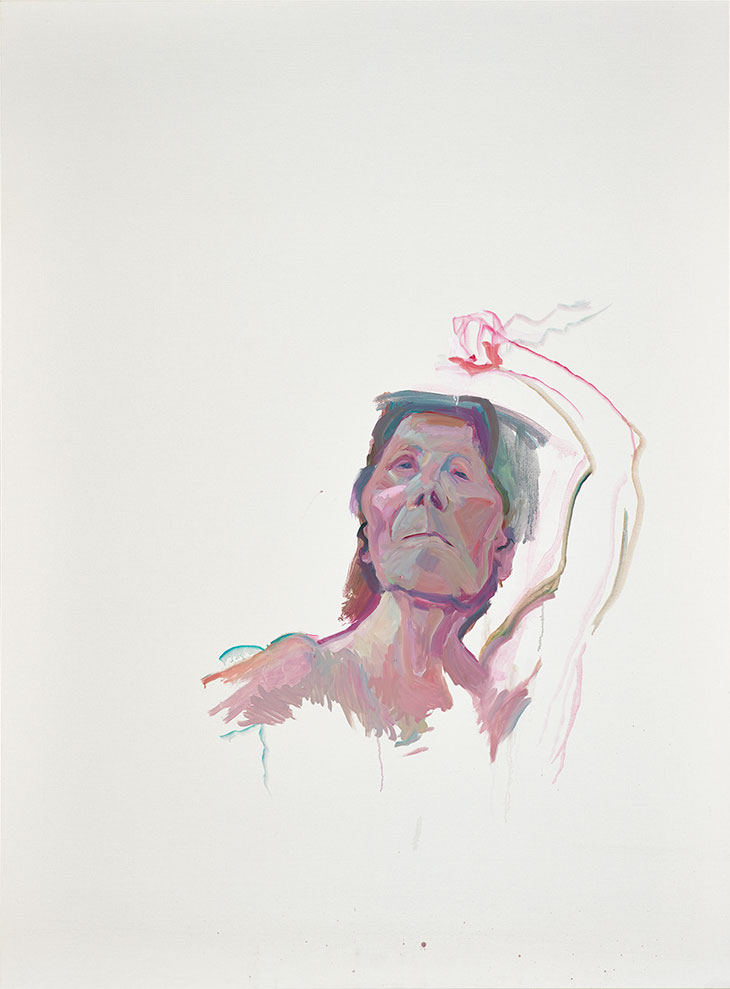If you could make visible the experience of having – or inhabiting – a body, what would that look like? This is the question Maria Lassnig (1919–2014) spent her career answering. The term she used for her project of visually recording physical sensations was ‘body awareness’. ‘I have been painting body awareness since I first began to paint,’ Lassnig wrote in 1970. ‘I can recommend it as an ideal artistic activity, for it is inexhaustible.’ The current survey at the Stedelijk Museum Amsterdam (travelling to the Albertina in September), organised to mark 100 years since the artist’s birth in the rural Austrian town of Kappel am Krappfeld, certainly bears out her case. Not only her paintings but also her drawings and collages, sculptures and films – more than 200 works in total, spread across 15 rooms – testify to the continual inspiration Lassnig derived from her mission.
Self-portrait as a Lemon (1949), Maria Lassnig. Photo: Roland Krauss; © Maria Lassnig Foundation

There were some false starts along the way. The earliest works on display were produced in the immediate aftermath of the Second World War, during which Lassnig had been a student at the Academy of Fine Arts in Nazi-controlled Vienna, where ‘everything modern was kept away from us’. Now a ‘magic realm of artistic -isms’ opened up to the young painter, which she set about emulating: Surrealist-inspired drawings with titles like Self-Portrait as a Lemon (1949); neat geometric and more gestural abstractions dancing between cubism and tachism. Increasingly she leaned towards the latter, stripping away any obvious figuration in a series of white-painted canvases, carved up with sinuous lines in rainbow colours: ‘a red of pain’, ‘juicy flesh tones’, green, blue. The brushstrokes are wide and loose; the layers of paint, liberally mixed with turpentine, are translucent like skin. But looking at these works, it’s hard to relate them to any physical experience beyond the act of painting itself. ‘I became a general laughingstock for calling my dumplings and masses of colors “self-portraits”,’ Lassnig recalled.
And so, from the early 1960s – around the time she moved to Paris, where she lived until 1968 – Lassnig decided to remove her restrictions on working from memory and observation, allowing something more clearly identifiable as the body to be perceived in her images. Self-portraits, a room of which opens this exhibition, remained her preferred format. There is no doubting who they depict – you quickly come to feel you would recognise Lassnig if you bumped into her on the street: blue, almond-shaped eyes; high cheekbones and dainty, upturned nose; thin lips, usually slightly parted. These true-to-life details serve to make the more fantastic elements – a brain exploding out from behind her ear (Lady with Brain, c. 1990–99); a withering, half-painted limb (The Yellow Hand, 2000) – even weirder, more disconcerting.
Lady with Brain (c. 1990–99), Maria Lassnig. © Maria Lassnig Foundation

When Lassnig started receiving wider attention after an exhibition at the Serpentine Gallery in 2008, frequent stylistic comparisons were made to the paintings of Francis Bacon and Lucian Freud. Certainly, the crouching, contorted and captive forms in works such as her Re-lations series of the early ’90s, which reveals something of the ambivalence Lassnig felt about human relationships and intimacy, would not be out of place on a Bacon canvas. Her more realist figures also seem to have something in common with Freud’s variegated expanses of exposed flesh. But for Lassnig, questions of surface and style – whether she is a realist or an expressionist or some other kind of painter – were beside the point. As she proclaimed in a series of ‘painting formulas’ laid out in 1951: ‘Discard the style! You exploit yourself [soon] enough.’ I am reminded of this when looking at a particularly Freudian self-portrait from 1971, in which the artist stands naked against a luminous green backdrop, clutching a pickle jar close to her frame. The green of the background seems to have permeated the outer layer of her skin, and infiltrated her hair follicles. A similar fusion of self and space takes place in an otherwise very different work, the feminist statement Woman Power (1979). The supersized body of a woman rises from a New York cityscape, a patchwork rendered in shades of blue, orange and yellow. The curves of her torso and her inner thigh are picked out in sky blue; flashes of orange and yellow appear along her arms and neck. Colour, form, figure, backdrop – everything here works towards the same goal: to capture the interface between our internal and external realities, how each is transformed by the other.
Woman Power (1979), Maria Lassnig. The Essl Collection, Albertina Museum, Vienna. Photo: Graphisches Atelier Neumann, Vienna; © Maria Lassnig Foundation

Although heavily critical of photography, which ‘only sees the surface’, Lassnig was more enthusiastic about the possibilities of film. On moving to New York in 1968, she attended classes in animation at the School of Visual Arts and in 1974 co-founded a film-making collective with other women artists including Carolee Schneemann and Martha Edelheit. Moving image – both animations of her drawings and filmed footage of real people – furnished her with a new tool to describe the sensation of being a body in constant flux, be that physical motion or shifts in feeling and identity. The animations are the most explicit in this regard – in Selfportrait (1971) the drawing of Lassnig’s face splits in two, is transformed into that of Greta Garbo, Bette Davis, a skull. Films such as Iris, made that same year, take a more abstract approach: Lassnig’s friend Iris Vaughan is portrayed naked in close-up shots from unfamiliar angles, with multiple exposures and reversed or rotating images.
Self-portrait with Brush (2010–13), Maria Lassnig. © Maria Lassnig Foundation

After returning to Vienna, where she lived until her death, Lassnig mostly stopped making films. Once more, there is the sense that variety – of style, medium, subject, tone – is the only appropriate response to the variety of life. The works produced in her later decades are as fresh as anything that precedes them, tackling the new experiences that came with her advancing age: bitterness at the economic need to continue teaching, and the feeling that her students were leeching off her talent; questions over whether she regretted not marrying or having children; the pain and degradation of illness and disability. The last work in the exhibition, Self-Portrait with Brush, was completed the year before Lassnig died – the year in which she received the Golden Lion for Lifetime Achievement at the Venice Biennale. The canvas is white as a page; the artist’s unmistakeable face and her shoulders float, disembodied, slightly below the centre. She has one limb – the sketched outline of an arm raised above her head, her fist a scribbled circle clenching a barely visible brush, which seems about to drift out of reach. The final metamorphosis is just around the corner.
‘Maria Lassnig: Ways of Being’ is at the Stedelijk Museum, Amsterdam, until 11 August.
From the July/August 2019 issue of Apollo. Preview and subscribe here.



